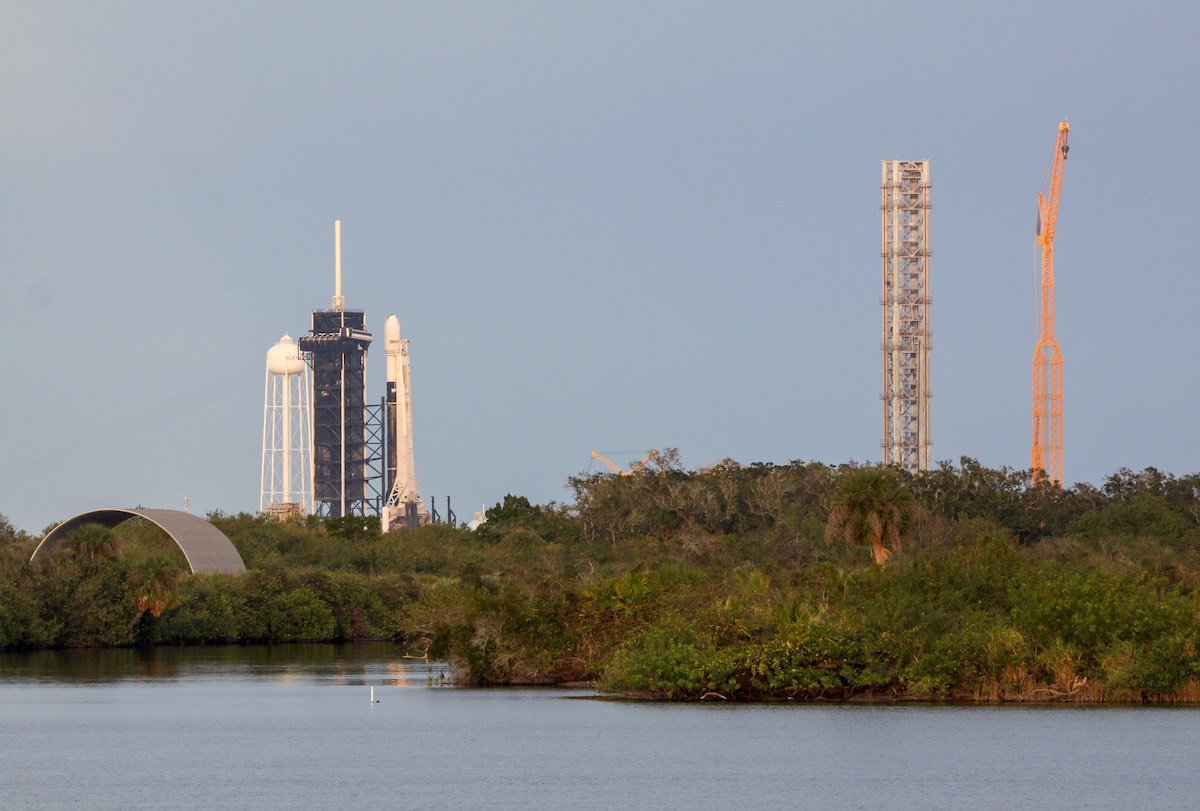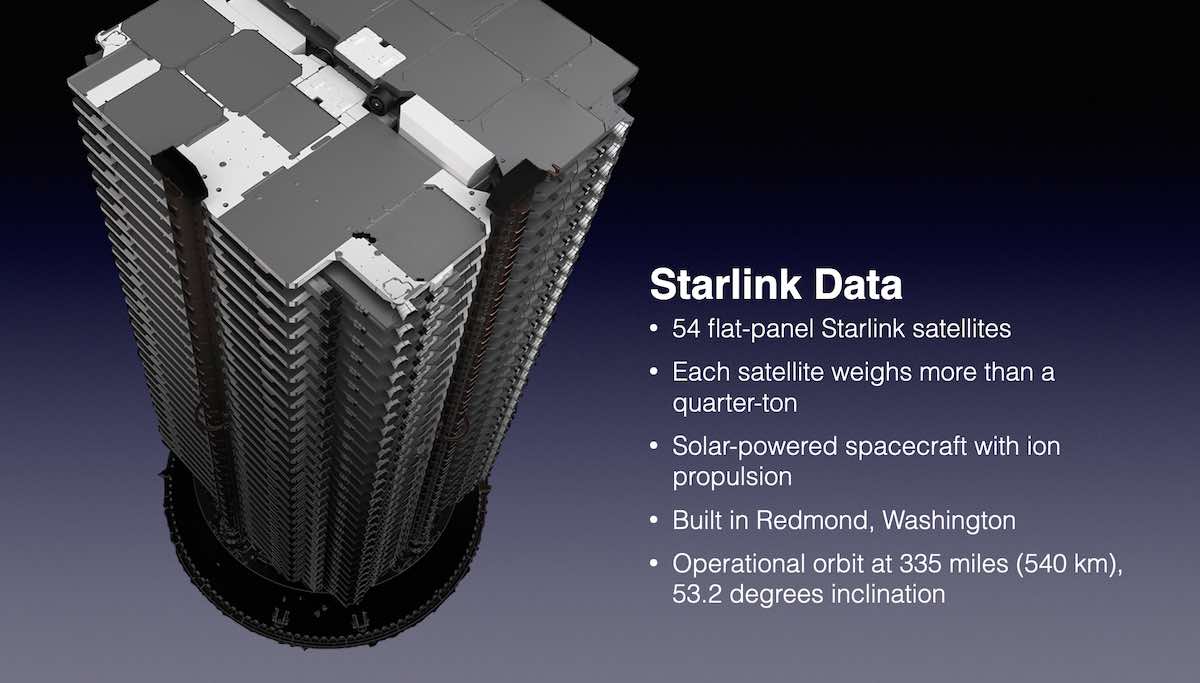Space News & Blog Articles
Live coverage: SpaceX booster to launch for record 15th time on Starlink mission
Live coverage of the countdown and launch of a SpaceX Falcon 9 rocket from Launch Complex 39A at NASA’s Kennedy Space Center in Florida. The Starlink 4-37 mission will launch SpaceX’s next batch of 54 Starlink broadband satellites. Follow us on Twitter.
SpaceX plans to launch 54 more Starlink internet satellites Saturday from Kennedy Space Center in Florida, using a Falcon 9 booster making its 15th flight to space, a record for the company’s reusable rocket fleet.
Liftoff of the 229-foot-tall (70-meter) Falcon 9 is set for 4:32 p.m. EST (2132 GMT) Saturday from Launch Complex 39A. SpaceX is going for its third Falcon 9 launch in less than 34 hours, following missions Friday from Cape Canaveral Space Force Station — just a few miles from pad 39A — and Vandenberg Space Force Base in California.
Those flights deployed the U.S.-French SWOT satellite, designed to survey Earth’s surface water resources, and two commercial broadband satellites for SES’s O3b mPOWER constellation.
SpaceX delayed the Starlink launch, designated Starlink 4-37, from Friday to focus on the O3b mPOWER mission for SES, one of SpaceX’s oldest customers.
There’s a 60% chance of favorable weather for the launch Saturday, with isolated rain showers and broken cloud layers predicted over Florida’s Space Coast, according to the U.S. Space Force’s 45th Weather Squadron. SpaceX has a backup launch opportunity available at 4:52 p.m., 20 minutes after the first launch time.
The Falcon 9 will arc northeast from Florida’s Space Coast, aiming for a low Earth orbit inclined 53.2 degrees to the equator. The rocket’s upper stage will release the 54 flat-packed Starlink satellites about 15 minutes into the mission.
The satellites on-board the Falcon 9 will add to SpaceX’s consumer-grade, high-speed, low-latency internet network. Subscribers can currently connect to the Starlink network in more than 40 countries and territories.
The first stage booster on the Starlink 4-37 mission will set a record for SpaceX’s reusable rockets. The booster stage, tail number B1058, debuted May 30, 2020, with the historic launch of NASA astronauts Doug Hurley and Bob Behnken on SpaceX’s first human spaceflight mission.
It’s flown 14 times so far, helping deliver 723 satellites into orbit. That tally will increase to 777 spacecraft with the launch of 54 more Starlink internet satellites Saturday.
The missions flown by B1058 have included the launch of a South Korean military communications satellite, a space station cargo mission, two Transporter small satellite rideshare missions, and nine flights with Starlink satellites.
 A Falcon 9 rocket stands on Launch Complex 39A on Dec. 16, ready for launch with 54 more Starlink internet satellites. Credit: Stephen Clark / Spaceflight Now
A Falcon 9 rocket stands on Launch Complex 39A on Dec. 16, ready for launch with 54 more Starlink internet satellites. Credit: Stephen Clark / Spaceflight Now
The launch Saturday will be SpaceX’s first Starlink mission since Oct. 27. Since then, SpaceX has launched nine consecutive missions for commercial and U.S. government customers.
After Saturday’s mission, SpaceX will have launched 3,612 Starlink satellites into orbit, including prototypes and failed spacecraft. The company currently has more than 3,200 functioning Starlink satellites in space, with about 3,000 operational and nearly 200 moving into their operational orbits, according to a tabulation by Jonathan McDowell, an expert tracker of spaceflight activity and an astronomer at the Harvard-Smithsonian Center for Astrophysics.
The 53 new Starlink satellites will launch into one of five orbital “shells” in SpaceX’s internet constellation.
SpaceX will Shell 4 with Saturday’s mission. The network architecture includes satellites flying a few hundred miles up, orbiting at inclinations of 97.6 degrees, 70 degrees, 53.2 degrees, and 53.0 degrees to the equator. The spacecraft beam broadband internet signals to consumers around the world, connectivity that is now available on all seven continents with testing underway at a research station in Antarctica.
SpaceX is more than halfway complete with deploying the initial fleet of 4,400 Starlink internet satellites. The company has approval from the Federal Communications Commission to eventually launch and operate up to 12,000 Starlink spacecraft, and SpaceX has signaled it could aim to fly as many as 42,000 Starlink satellites in orbit.
SpaceX is developing an upgraded, much larger Starlink satellite design sized to launch on the company’s huge next-generation Starship rocket. But the Starship has not yet attempted a launch into low Earth orbit, and delays in developing and testing the new rocket will likely force SpaceX to start launching a smaller version of the new Starlink satellite design on Falcon 9 rockets.
The Starlink network was conceived as a venture to help draw in revenue to fund SpaceX’s ambition to build a base on Mars. The Starship rocket itself, designed to be fully reusable with relatively low operating costs, is central to Elon Musk’s Mars dream.
The launch Saturday will be SpaceX’s 59th launch so far in 2022. Two more Falcon 9 rockets are scheduled to fly before the end of the year, one from Florida and one from California.
The higher launch rate has been aided by shorter turnarounds between missions at launch pads in Florida and California, and SpaceX’s reuse of Falcon 9 boosters and payload fairings. Launches carrying satellites for SpaceX’s own Starlink internet network, like the mission Saturday, have accounted for more than half of the company’s Falcon 9 flights so far this year.
 Credit: Spaceflight Now
Credit: Spaceflight Now
Stationed inside a launch control center just south of Cape Canaveral Space Force Station for Saturday’s countdown, SpaceX’s launch team will begin loading super-chilled, densified kerosene and liquid oxygen propellants into the Falcon 9 vehicle at T-minus 35 minutes.
Helium pressurant will also flow into the rocket in the last half-hour of the countdown. In the final seven minutes before liftoff, the Falcon 9’s Merlin main engines will be thermally conditioned for flight through a procedure known as “chilldown.” The Falcon 9’s guidance and range safety systems will also be configured for launch.
After liftoff, the Falcon 9 rocket will vector its 1.7 million pounds of thrust — produced by nine Merlin engines — to steer northeast over the Atlantic Ocean.
The rocket will exceed the speed of sound in about one minute, then shut down its nine main engines two-and-a-half minutes after liftoff. The booster stage will release from the Falcon 9’s upper stage, then fire pulses from cold gas control thrusters and extend titanium grid fins to help steer the vehicle back into the atmosphere.
Two braking burns will slow the rocket for landing on the drone ship “Just Read the Instructions” around 400 miles (650 kilometers) downrange approximately nine minutes after liftoff.
The Falcon 9’s reusable payload fairing will jettison during the second stage burn. A recovery ship is also on station in the Atlantic to retrieve the two halves of the nose cone after they splash down under parachutes.
Landing of the first stage on Saturday’s mission will occur moments after the Falcon 9’s second stage engine cuts off to deliver the Starlink satellites into orbit. Separation of the 54 Starlink spacecraft, built by SpaceX in Redmond, Washington, from the Falcon 9 rocket was confirmed at T+plus 15 minutes, 22 seconds.
Retention rods will release from the Starlink payload stack, allowing the flat-packed satellites to fly free from the Falcon 9’s upper stage in orbit. The 54 spacecraft will unfurl solar arrays and run through automated activation steps, then use krypton-fueled ion engines to maneuver into their operational orbit.
The Falcon 9’s guidance computer aims deploy the satellites into an elliptical orbit at an inclination of 53.2 degrees to the equator. The satellites will use on-board propulsion to do the rest of the work to reach a circular orbit 335 miles (540 kilometers) above Earth.
After reaching their operational orbit, the satellites will enter commercial service and begin beaming broadband signals to consumers, who can purchase Starlink service and connect to the network with a SpaceX-supplied ground terminal.
ROCKET: Falcon 9 (B1058.15)
PAYLOAD: 54 Starlink satellites (Starlink 4-37)
LAUNCH SITE: LC-39A, Kennedy Space Center, Florida
LAUNCH DATE: Dec. 17, 2022
LAUNCH TIME: 4:32:30 p.m. EST (2132:30 GMT)
WEATHER FORECAST: 60% chance of acceptable weather; Low risk of upper level winds; Low-moderate risk of unfavorable conditions for booster recovery
BOOSTER RECOVERY: “Just Read the Instructions” drone ship east of Charleston, South Carolina
LAUNCH AZIMUTH: Northeast
TARGET ORBIT: 144 miles by 208 miles (232 kilometers by 335 kilometers), 53.2 degrees inclination
LAUNCH TIMELINE:
T+00:00: Liftoff T+01:12: Maximum aerodynamic pressure (Max-Q) T+02:27: First stage main engine cutoff (MECO) T+02:31: Stage separation T+02:38: Second stage engine ignition T+02:42: Fairing jettison T+06:47: First stage entry burn ignition (three engines) T+07:06: First stage entry burn cutoff T+08:28: First stage landing burn ignition (one engine) T+08:41: Second stage engine cutoff (SECO 1) T+08:49: First stage landing T+15:22: Starlink satellite separationMISSION STATS:
192nd launch of a Falcon 9 rocket since 2010 201st launch of Falcon rocket family since 2006 15th launch of Falcon 9 booster B1058 164th Falcon 9 launch from Florida’s Space Coast 59th SpaceX launch from pad 39A 153rd launch overall from pad 39A 131st flight of a reused Falcon 9 booster 66th Falcon 9 launch primarily dedicated to Starlink network 58th Falcon 9 launch of 2022 59th launch by SpaceX in 2022 56th orbital launch attempt based out of Cape Canaveral in 2022This email address is being protected from spambots. You need JavaScript enabled to view it. the author.
Follow Stephen Clark on Twitter: @StephenClark1.
When you subscribe to the SpaceZE News Feed, we will send you an e-mail when there are new updates on the site so you wouldn't miss them.

